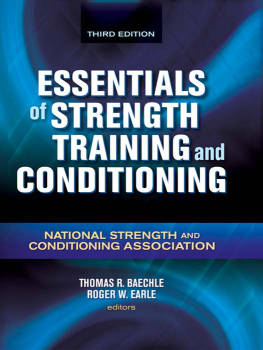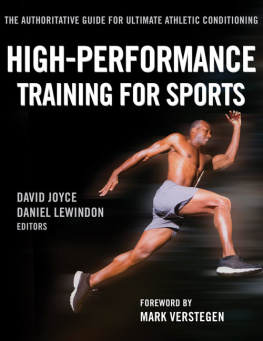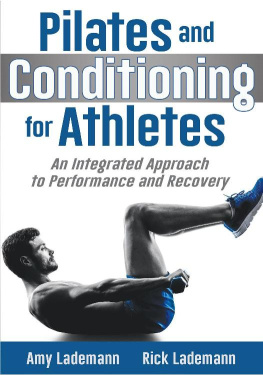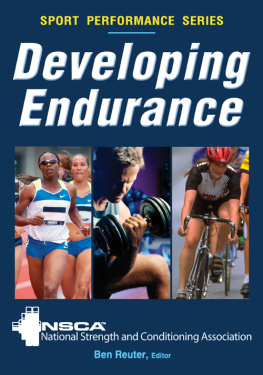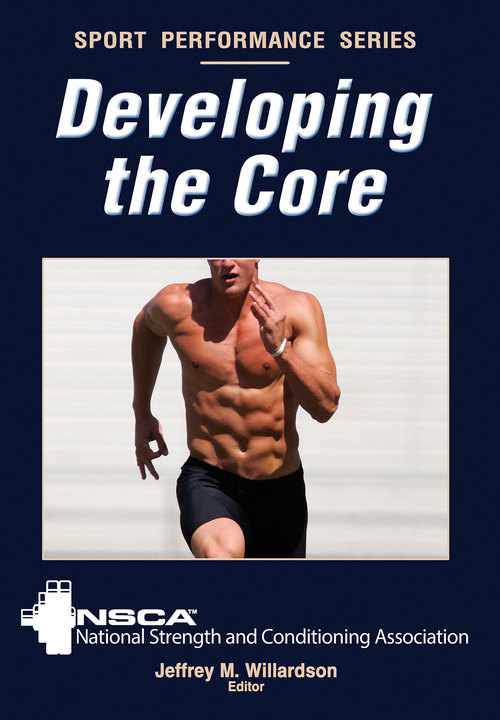
Library of Congress Cataloging-in-Publication Data
Developing the core / National Strength and Conditioning Association and Jeffrey M. Willardson, editor.
pages cm. -- (Sport performance series)
Includes bibliographical references and index.
1. Exercise. 2. Abdominal exercises. 3. Abdomen--Muscles. I. Willardson, Jeffrey M. II. National Strength & Conditioning Association (U.S.)
GV508.D48 2014
613.7'1--dc23
2013019510
ISBN-10: 0-7360-9549-7 (print)
ISBN-13: 978-0-7360-9549-5 (print)
Copyright 2014 by National Strength and Conditioning Association
All rights reserved. Except for use in a review, the reproduction or utilization of this work in any form or by any electronic, mechanical, or other means, now known or hereafter invented, including xerography, photocopying, and recording, and in any information storage and retrieval system, is forbidden without the written permission of the publisher.
The web addresses cited in this text were current as of May 2013, unless otherwise noted.
Assistant Acquisitions Editor: Justin Klug
Developmental Editor: Carla Zych
Assistant Editor: Rachel Fowler
Copyeditor: Patricia MacDonald
Indexer: Nancy Ball
Permissions Manager: Martha Gullo
Graphic Designer: Nancy Rasmus
Cover Designer: Keith Blomberg
Photograph (cover): Liam Foley/Icon SMI
Photographs (interior): Neil Bernstein, unless otherwise noted
Photo Asset Manager: Laura Fitch
Visual Production Assistant: Joyce Brumfield
Photo Production Manager: Jason Allen
Art Manager: Kelly Hendren
Associate Art Manager: Alan L. Wilborn
Illustrations: Human Kinetics
Printer: United Graphics
We thank National Strength and Conditioning Association in Colorado Springs, Colorado, for assistance in providing the location for the photo shoot for this book.
Human Kinetics books are available at special discounts for bulk purchase. Special editions or book excerpts can also be created to specification. For details, contact the Special Sales Manager at Human Kinetics.
Printed in the United States of America
10 9 8 7 6 5 4 3 2 1
The paper in this book is certified under a sustainable forestry program.
Human Kinetics
Website: www.HumanKinetics.com
United States: Human Kinetics
P.O. Box 5076
Champaign, IL 61825-5076
800-747-4457
e-mail: humank@hkusa.com
Canada: Human Kinetics
475 Devonshire Road Unit 100
Windsor, ON N8Y 2L5
800-465-7301 (in Canada only)
e-mail: info@hkcanada.com
Europe: Human Kinetics
107 Bradford Road
Stanningley
Leeds LS28 6AT, United Kingdom
+44 (0) 113 255 5665
e-mail: hk@hkeurope.com
Australia: Human Kinetics
57A Price Avenue
Lower Mitcham, South Australia 5062
08 8372 0999
e-mail: info@hkaustralia.com
New Zealand: Human Kinetics
P.O. Box 80
Torrens Park, South Australia 5062
0800 222 062
e-mail: info@hknewzealand.com
E5184
Contents
Jeffrey M. Willardson
Thomas W. Nesser
David Behm
Brad Schoenfeld and Jay Dawes
James Di Naso
David J. Szymanski
Russ Malloy
Patrick McHenry
Greg Rose
Joel Raether
Brijesh Patel
Scott Riewald
Mark Kovacs
Jeffrey Kipp
Allen Hedrick
Eric Childs
Introduction
One of the most important priorities for all athletes should be to ensure adequate conditioning of the core musculature. In recent years, there has been considerable literature in both the popular media and scientific journals on the importance of these muscles for effective movement and sports performance. It should be recognized that the core of the body includes both passive skeletal and active muscle and neural components. A crucial role of the core musculature is to maintain the stability of the trunk. In this regard, the early literature regarding core muscle training stemmed from physical therapy and athletic training settings, for alleviating low back pain and correcting faulty posture.
For healthy people, core muscle training is theorized to improve sports performance by enhancing the stiffness of the trunk, thereby providing a platform that enables greater torque production in the upper and lower extremities. In other words, a stable trunk enables athletes to push, pull, kick, or throw with more force. However, greater torque production is of little value without the neurologically orchestrated steering and transfer of torque through the skeletal segments. Therefore, core muscle training for athletes is not necessarily focused on developing maximal strength so much as on developing greater motor control. This is achieved through an individualized progression of exercises that involve a variety of core muscle recruitment patterns similar to what might be encountered during sports competition.
The majority of strength and conditioning professionals have always advocated prescription of less stable standing movements with free weights (and cables) versus more stable seated movements on machines in the preparation of athletes. A major disadvantage of such machine-based training is the limited trunk stabilization requirements and nonspecific postures relative to most sports skills. In the last decade, there has been increased emphasis on prescribing exercises that position the body (through various stances and postures) to enhance the motor control requirements of the core musculature and create the optimal combination of trunk stability and mobility that is movement specific.
This book is the first to comprehensively address several key issues related to specific training for the core musculature. It brings together an excellent group of sports scientists and practitioners to provide the most cutting-edge and accurate information available, beginning with a foundational chapter to establish the anatomical definition of the core based on current scientific consensus. Most strength and conditioning professionals would agree that the abdominal and low back muscle groups are considered core muscles. However, this book addresses the function of several other core muscles, including those that connect the trunk with the upper and lower extremities as well as the neurological integration and the biomechanical contribution of the core muscles in creating efficient movement.
One of the key issues in prescribing appropriate exercises for the core musculature is establishing a persons level of core muscle function, including the ability to stabilize the trunk and to move the trunk. Assessment and training include both isometric and dynamic actions that can be progressively combined with actions of the upper and lower extremities. Developing the Core includes the latest scientifically validated and reliable battery of testing and assessment procedures that can be readily incorporated into most training settings. Exercise prescription can then be based on the level of motor control and a persons specific weaknesses.
A key issue with core muscle training is that the exercise modalities recommended in physical therapy or athletic training settings may not provide a sufficient stimulus for greater adaptation for healthy people. Therefore, the principles of overload and progression are key factors to consider in prescribing core muscle exercises. This book includes discussion of studies on core muscle involvement and the safest methods to load these muscles, with progressions and general prescriptive guidelines that can be applied with people of all athletic abilities.
Next page

